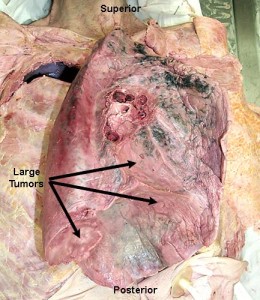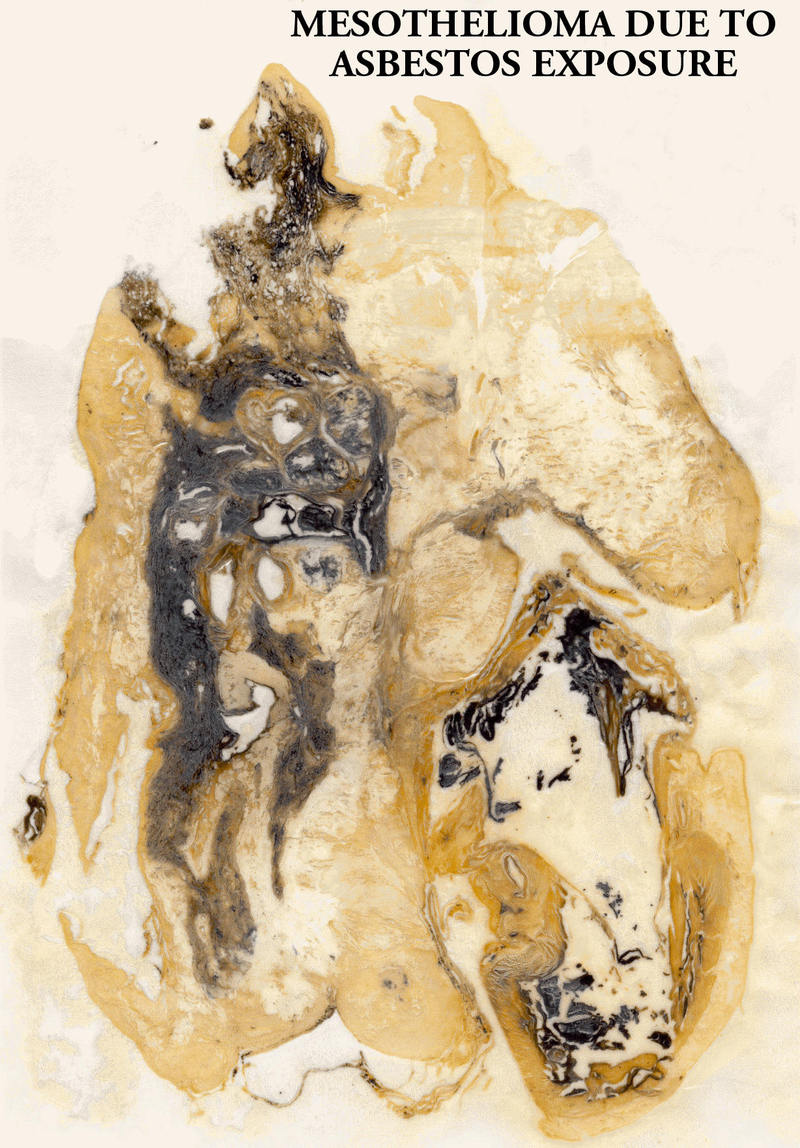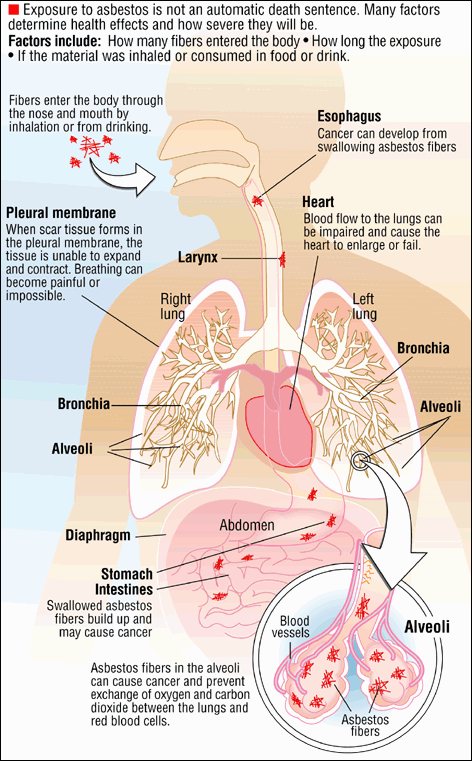Asbestos Disease
The microscopic fibres that form asbestos are a deadly threat to human health when they become airborne and are inhaled. From as early as the 1940s these persistent tiny fibres have been claiming many Australian lives. These fibres are too small for the body to expel, and consequently they can remain embedded in lung tissue until one’s health begins to deteriorate. The most common health concerns and cause of death caused by inhalation of asbestos fibres are: pleural disease, asbestosis, lung cancer, and mesothelioma
Pleural Disease
When asbestos fibres are transported by the lung parenchyma or through lymphatic pathways, their presence in its tissue can cause any or all of the following abnormalities: benign asbestos effusion, parietal pleural plaques, diffuse pleural fibrosis and rounded atelectasis. The constant irritation of the lungs tissues by the fibres causes the pleura to thicken or widen. This can cause serious breathing complications, and ultimately a person’s death. The formation of pleural plaques is not considered cancerous, but has been known to trigger other asbestos-known cancers.
Lung Cancer
 Tobacco smokers that inhale asbestos fibres are more likely to develop lung cancer. Research has shown that the presence of both substances in the human lungs increases the probability of developing lung cancer 16-fold in cigarette smoking asbestos insulators. Once the deadly fibres are inhaled, the victim generally lives another 20-30 years before the onset of the disease.
Tobacco smokers that inhale asbestos fibres are more likely to develop lung cancer. Research has shown that the presence of both substances in the human lungs increases the probability of developing lung cancer 16-fold in cigarette smoking asbestos insulators. Once the deadly fibres are inhaled, the victim generally lives another 20-30 years before the onset of the disease.
Asbestosis
 The scarring of lung tissues by asbestos fibres causes asbestosis. The asbestos disease causes an inability of the lungs to transfer oxygen, which can lead to death as a result of intractable respiratory failure. When the disease is fully developed, a blue tinge usually appears on the skin due to a lack of oxygen in the blood. During development the lungs become stiff and lack their normal elastic properties.
The scarring of lung tissues by asbestos fibres causes asbestosis. The asbestos disease causes an inability of the lungs to transfer oxygen, which can lead to death as a result of intractable respiratory failure. When the disease is fully developed, a blue tinge usually appears on the skin due to a lack of oxygen in the blood. During development the lungs become stiff and lack their normal elastic properties.
Mesothelioma
 Mesothelioma—otherwise known as malignant mesothelioma—is commonly found in the pleura, peritoneum, pericardium or tunica vaginalis. It is considered a rare cancer that affects a small percentage of people that inhaled asbestos. Symptoms and signs from the initial exposure to asbestos usually include shortness of breath, weight loss, build-up of fluid in the abdominal cavity, and shortness of breath. The signs can appear between 20-50 years, and survival time after diagnosis is usually 6-18 months.
Mesothelioma—otherwise known as malignant mesothelioma—is commonly found in the pleura, peritoneum, pericardium or tunica vaginalis. It is considered a rare cancer that affects a small percentage of people that inhaled asbestos. Symptoms and signs from the initial exposure to asbestos usually include shortness of breath, weight loss, build-up of fluid in the abdominal cavity, and shortness of breath. The signs can appear between 20-50 years, and survival time after diagnosis is usually 6-18 months.

Are you prepared to be responsible for deaths within your workplace?
The truth is, every year thousands of people become victims of Asbestos related illnesses.
Australia has the 2nd highest rate of asbestos related cancer deaths in the world. WHO estimated over 107,000 people die each year as a result of asbestos related lung diseases. Over 40% of people exposed to long term asbestos contact will develop some type of illness; the trouble is knowing how badly each will be affected.
Working in an environment with asbestos is like playing Russian roulette with your health. Are you prepared to take that risk?
Why encourage lung disease and cancers, when you can prevent it today?
Quality Building Management has highly qualified staff, ready to help your company now. We have trained experts, providing the current testing and auditing –each test backed by legislation. We can help you
- 1. Stop worrying about workplace safety because of asbestos
- 2. Promote a safe, healthy environment
- 3. Develop an asbestos treatment plan
- 4. Provide in-depth reports on any findings
Your Company’s Security Depends on Proper Asbestos Auditing.
Are you willing to jeopardize your company’s reputation, finances and well-being at the hands of non-compliance? If you agree that’s too much to risk, you need to act before it’s too late. Don’t become a victim to asbestos—GET STARTED TODAY!
Deadly Statistics
- 659 new cases of mesothelioma in Australia in 2019
- 701 people diagnosed with mesothelioma each year in Australia since 2011
- From 1982 – 2019, the number of new cases of mesothelioma rose from 135 to 532 for males and 22 to 127 for females in Australia
- Next to the United Kingdom, Australia has the highest rate of asbestos-related cancer deaths in the world.
- According to cancer experts, an additional 25,000 Australians are expected to die over the next four decades from mesothelioma
- In 2007, 551 Australians who registered that year died of mesothelioma. Eighty-four percent of those individuals were men.
- Experts suggest that the number of deaths from mesothelioma will peak somewhere between 2014 and 2021
- Incidence of the disease in New South Wales nearly doubled in the 20 years between 1987 and 2006.
- The rate among females in New South Wales tripled during 1987 and 2006, with many cases attributed to second-hand
- Over the period 1982 to 2006, the total number of new cases of mesothelioma increased from 156 to 649
- From 1997 the number of deaths has increased from 416 to 628 in 2006
- There was a 25% increase in accepted asbestos claims from 2003 to 2008
- Deaths from Asbestosis increased 253% from 1998 to 2008
- About 125 million people in the world are exposed to asbestos in their workplace
- WHO estimates that 107,00 people die each year from asbestos related lung diseases
References:
Australian Institute of Health and Welfare 2020
Safe Work Australia
Asbestos.com
World Health Organisation July 2010
Sources:
Pathology of Asbestos Associated Diseases; Victor L Roggli et al.
Asbestos Related Diseases: http://www.nhmrc.gov.au/your-health/asbestos-related-diseases

